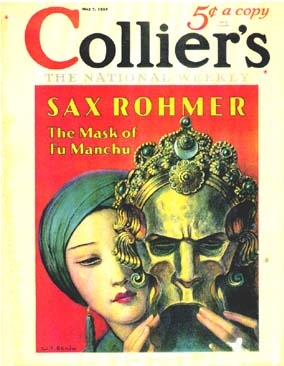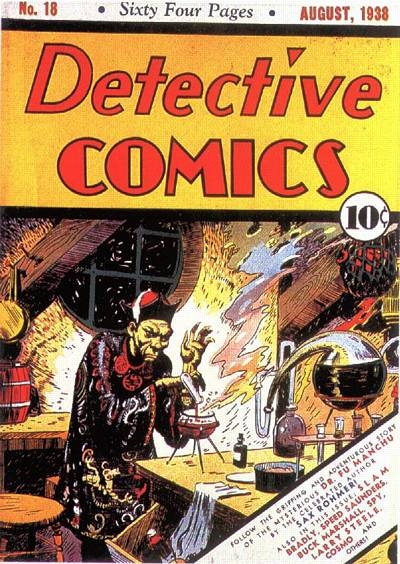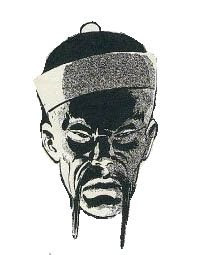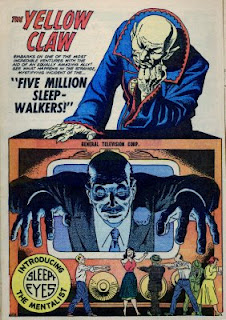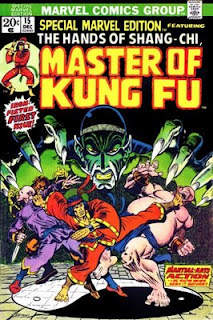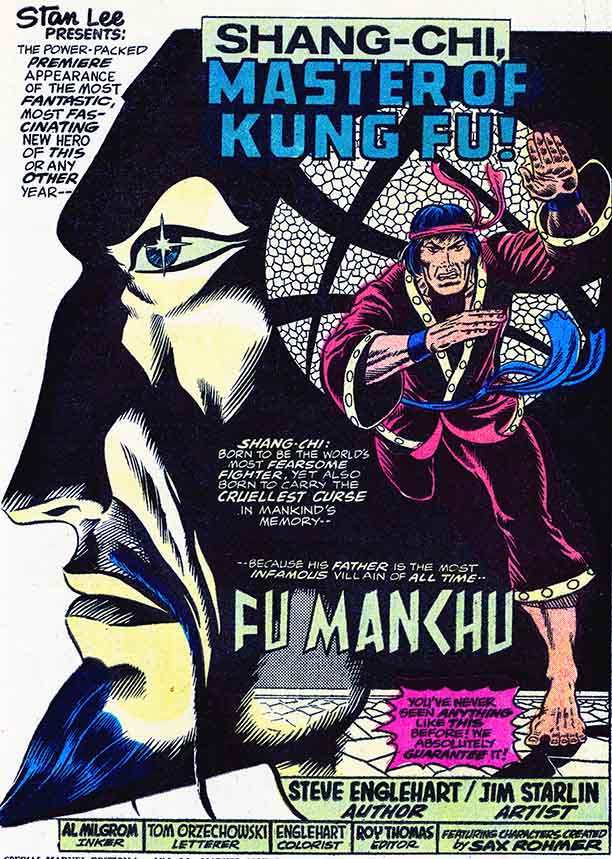Sadly we might lose so great stories and some great ideas unless they become public domain. Many Marvel stories will be Lost in Licensing. As Marvel’s Conan the Barbarian, by Robert E. Howard, grew, it began to license famous literary characters, starting with Red Sonja and Kull were added. Some of their best comics of the time were of licensed or familiar characters. (Dracula and Frankenstein were now in public domain.) The reprint market has grown to be a huge part of their business. Trade paperbacks, Masterworks and even just plan comic book reprints make a lot of money. Sadly, as licensing lapses, so does Marvel’s rights to reprint those stories. Master of Kung Fu, which featured Fu Manchu, is one of those victims. New Marvel readers may never get the opportunity to read these wonderful stories.
While other publishers have picked up the rights to reprint Conan, a few Conan stories that featured Marvel characters may never be reprinted again. That includes What If? #13, #43, and #29 which featured the Watcher and Thor. There was a trial run on Conan in Chamber of Darkness #4, using a character with a similar name. I wonder if that can be reprinted anywhere. So part of the Marvel Age may be lost.
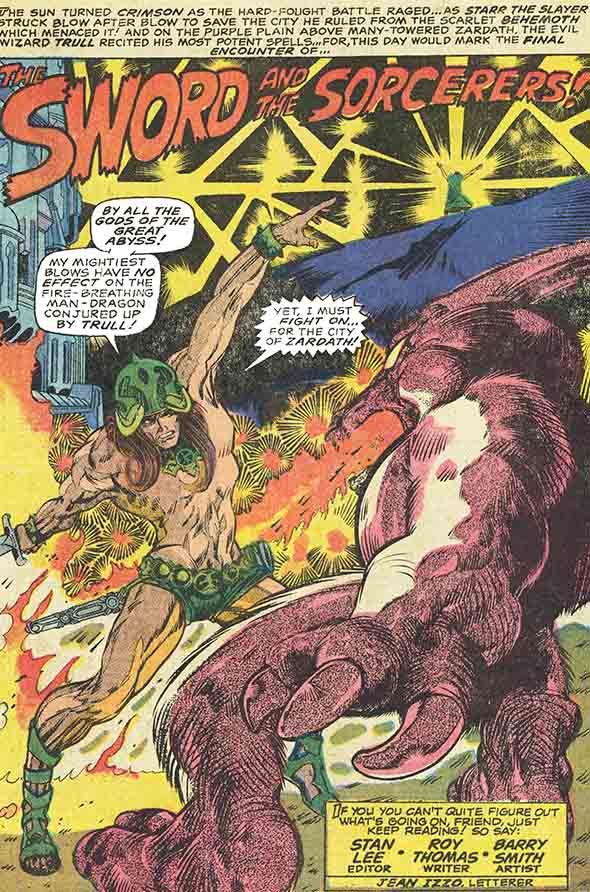
There was also Thongor, Planet of the Apes, Doc Savage, Gullivar Jones, Logan’s Run and several movies and science fiction stories that were adapted in comics such as Worlds Unknown.
Machine Man was a character created by Jack Kirby that made his first appearance in 2001: A Space Odyssey. The character is still used, but there are no references to 2001. There may be no reprinting of it either.
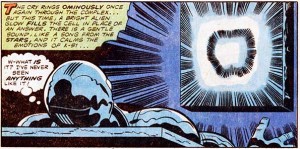
One irony: Deathlok was originally based on Cyborg, the novel that The Six Million Dollar Man was based on. When Marvel did not get the comic book rights (after they were sold to TV) they altered the story to make it their own. So they got the keep the character, instead of losing somewhere in the infinite corridors of licensing.
Master of Kung Fu may not be seen again because it featured Fu Manchu, one of the few characters Marvel used that had appeared in other comics. MOKF becomes one of the best written and drawn series of the later Marvel Age. Paul Gulacy and Jim Starlin and captured and kept the wonderful, distinctive mood and atmosphere. Here, there is something new and different in the world of comics. On TV Kung Fu was a popular show. Just like The Man from U.N.C.L.E. had its roots in the James Bond movies, Kung Fu was inspired by the popular Bruce Lee and his films such as Enter the Dragon.
The Insidious Dr. Fu Manchu a story of an evil genius, was published in 1913 and its main character would have a long run in pulps, movies, comics and magazines. “Imagine a person, tall, lean and feline, high-shouldered, with a brow like Shakespeare and a face like Satan. . .one giant intellect, with all the resources of science past and present. . .Imagine that awful being, and you have a mental picture of Dr. Fu-Manchu, the yellow peril incarnate in one man.”
In 1932 Colliers published a 12-part story, The Mask of Fu Manchu. Wladyslaw Theodor Benda drew the cover.
Fu Manchu’s comic history would begin in daily strips from 1930-1932. These stories were reprinted in Detective Comics starting with issue #17. Previously, Fu Manchu was copied in Detective Comics #1, in the Slam Bradley story by Superman’s creators, Siegel and Shuster. Wally Wood, in 1950 would also draw The Mask of Fu Manchu for Avon Comics.
You cannot underestimate Fu Manchu’s influence on popular fiction at the time. He was copied everywhere. The Yellow Claw, a Fu Manchu copy by Atlas (Marvel’s name then), appeared in his own comic, drawn with the incredible talents of Jack Kirby and Joe Maneely, from 1956-1957. In 1967, Jim Steranko brought him back (well sort of) for the Nick Fury in Strange Tales #160-167. Some of Marvel’s artists and writers began emulating Jim Steranko’s artwork, pacing and story lines and it was evident in these stories. The Mandarin was the most modern copy of Fu. He first appeared in Tales of Suspense in the Iron Man stories, and has since become a fixture in the Iron Man cartoons and is hinted at in the movie.
In 1973, Marvel licensed the character of Fu Manchu from the Rohmer estate and featured him as Shang-Chi’s father. This Fu Manchu and Steranko’s Yellow Claw seemed, in appearance and in their actions, to be twins separated at birth. This meant removing any trace of communist leanings from Fu Manchu. The reprints of the Yellow Claw that appeared, mostly, in Giant-Size Master of Kung Fu featured “doctored” artwork and text to conform to Steranko’s plot lines. This took out the FBI and the communists and replaced them with S.H.I.E.L.D. agents and Hydra. Marvel wanted to connect the characters, making them almost seem related. Certainly their look was similar. There was more innovation and adult themes here than in other current series of the time. When the license ended on Fu Manchu he disappeared from the comic, about issue #151.
“On Yellow Claw, when you describe him as the prototype of Fu Manchu, that’s true if you mean Marvel’s Fu Manchu, but Marvel took Fu from Sax Rohmer, who was the prototype for Yellow Claw in the first place, so in that sense the original Fu was the prototype for Yellow Claw, as well as Mandarin.”
Steve Englehart: “I had a few friends up to my place in Connecticut for a weekend, and we were about to go out and get some dinner when Steve Harper, the artist, said he’d stick around to watch the second episode of a TV show he liked called Kung Fu. We were dubious but he put off dinner for an hour, and I totally fell in love with that show–as did Jim Starlin, who was also there. When the third episode came around, Jim and I were down in New York, and I guess Jim didn’t have a TV, so we asked Roy Thomas if we could watch it at his house. Roy was dubious, and remained so, but we remained enthralled, so without my pretense whatsoever, Jim and I created our own version of what we liked. (Then Roy, who loved old pulp [as did I], had us add Fu Manchu to the mix.)”


